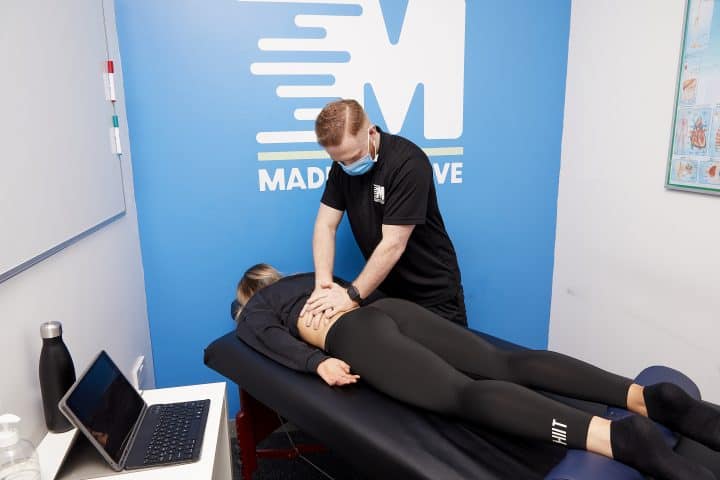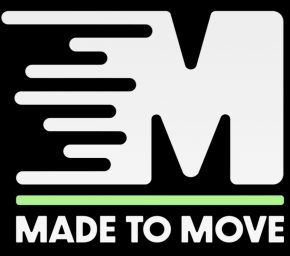The use of sports massage is often disregarded by some professionals and may be over utilised by other professionals because of the short-term effects. However, the long-term effects out there is not shown to be too beneficial. The way we use sports massages within Made to Move is used as part of a strategy rather than just a primary service. With anything, there needs to be a context in what you’re trying to achieve, to be able to utilise it effectively.
So those of you who are new to a sports massage or might be new to fitness and might have heard of this concept, read on to discover what it is and what it covers.
PS: Read on to see our exciting 20% discount available for you at the end of this article!
What is a sports massage?
Sports massage is a type of soft tissue therapy that’s used to utilise deep tissue techniques to be able to relieve the muscular tension that someone is experiencing. It is also used to help modulate pain. For example, this can be dampening down the nervous system signals, to allow a greater window of less pain after.
The context we are going to be looking over today is the myths that tend to be thrown around by people who maybe don’t understand it too much. But also, people in old traditional methods of massage might tend to think this is what a sports massage is. And then finally, I’ll summarise this article to hopefully give you a bit more of an insight in terms of what sports massages is and how you can confidently go and get one.
So, it is time for some myth-busting! Something I’ve been holding off from. However, I think it is a concept I want to cover. But perhaps, for you, this will be quite beneficial. So, let’s get started!
Myth 1: Sports massage is supposed to be painful
Is sports massage supposed to be painful? Often, it does feel very, very uncomfortable. But why?
Well, nerve endings tend to be closer together when your muscles are tight and stiff, but just because of where the tissue has been laid, and are being held. So, at the start, it can be rather discomforting as a new sensation for the body to be recognising. But as you’re going through this with the therapist, they should be taking it steadily, gradually increasing the pressure, until we’re at a point where you’re finding it a little uncomfortable but tolerable.
If you’re going in there and being smashed up by a therapist and finding it sorer for continual days after (a few days after is too expected, just like after an intense workout) You should maybe rethink going back. It is important to understand that it doesn’t have to be painful and intolerable, it needs to be slightly uncomfortable. Being able to communicate with your therapist, in terms of pressure and pain is vital during the session and multiple times during a session (It is going to make their job a lot easier!).
Myth 2: Is sports massage for athletes or people in sports only?
I think that is down to traditional thoughts, and maybe even just the word sports massage that suggests that it is only for those in sport.
However, we use this service with a wide range of clientele for people that are not just in sport. And these can be those suffering from aches, pains, and soreness. They might have postural habits, and pain associated with these. They might be coming in with reoccurring headaches, or maybe a previous recurring strain that is not getting better.
Often those who have desk related jobs commonly have elbow, neck, back and knee pain. These areas can also be helped by relieving symptoms by a sports massage. And by understanding those in manual labour in jobs, who are probably doing the more physical activity than someone who is in sport, they’re the people that should be taking this on more frequent to allow them to recover from high-intensity bouts, maybe reverse the effects from work, and the repetitive nature of their jobs.
If you’re integrating this as part of a lifestyle plan to allow you to move, exercise, work and enjoy normal movement patterns within your daily lifestyle, you’ll know the benefits of how it makes you feel. So just referring back to this point, sports massage is not just for athletes, it is not just for people who are in sport, it is just a typical term that’s used because they are those who implement it as a recovery method.

Myth 3: One massage is all you need to feel better…
I think this needs to be played into the context of what your symptoms are, what your physical activity is like, what your sport and your job role are. In terms of that, this will give you your answer.
So, someone who is more physically active does more strenuous work, lifts heavier, have high-intensity exercise regimes, will have more benefit in doing more regular massage sessions. Whereas someone who might be sitting in a desk related role, might not need it as much. However, like a car has a “service” or “MOT” it is necessary to ensure all the systems are working efficiently to maximise its performance and reduce future injury risk.
To understand it personally, look at your body as a vehicle, you cannot be running at 100% all of the time. You are accumulating stress on the body, you are lengthening and shortening muscles for an extended time – daily, you may be overworking muscles with small amounts of time to recover. One massage might be good for a short window of time. However, again, going back to your nature of work or sport, that’s going to give you more indication of how regularly you need one.
I think this is where the new age of understanding physical well-being and health is important to create a lifestyle strategy to allow you to move and train optimally. But also, being able to look after yourself is something even more important.
Myth 4: Is sports massage specific to a type of sport?
So, myth number four, is sports massage specific to a type of sport? My answer to that would be no. It can be used throughout any type of sport, depending on what your goal is, what your current ability is. But also know in terms of have you got a recovery strategy in place?
The trick is to think of it as more of a goal rather than a certain sport. In terms of a certain goal, it might mean that you’ve got a full year’s worth of events planned out. So, how you’re going to be able to prepare for the next one but recover from the previous event, I think that’s an important thing to look at, which then you can start to put a strategy in place.
It might mean that you have an ache or pain. So, your next strategy is to go right, how can I get rid of this pain? The first thing we need to do is actually to die down this over-sensitivity, then once you’ve got that window of opportunity for more movement and less pain, build upon that through an exercise protocol. And then that’s the way we like to use that within our Made to Move.
For example, if we’re looking at a knee injury, we’re going to start to work on any restrictions around the knee, hip and ankle joints, we will then start to look at other deficits such as stability work around the ankle and the hips. And then from that, you can then start to progress into more intensive exercises. If you are in pain, or you’re finding that you’ve got a chronic tightness, the important thing is to look at: what is the flexibility and mobility like to start with? Then how do we look at it in terms of stability?
Finally, as a quick note, make sure that you are doing your research in terms of who you’re getting your sports massage from, making sure they’re accredited, making sure there are recommendations and reviews. Maybe you’ve got some friends or family that know someone. That’s always more important to have. But if you’ve got any questions or queries then please do let us know in the comments below.
So, if you found this useful, please leave a comment down below.
If you’re on any of our platforms, please share this with a friend or family member who is curious about what sports massage is. This could be the first step to allow them to take that step into booking a consultation or even a sports massage session with ourselves or even maybe someone closer to them.
As promised! Here is our exciting discount available for you at the end of this article!
If you’re looking to get a sports massage after reading this article, or if you’re intrigued in terms of how it might help you specifically, leave your contact details below to gain access to our discount code
FOR 20% OFF YOUR FIRST SPORTS MASSAGE.

